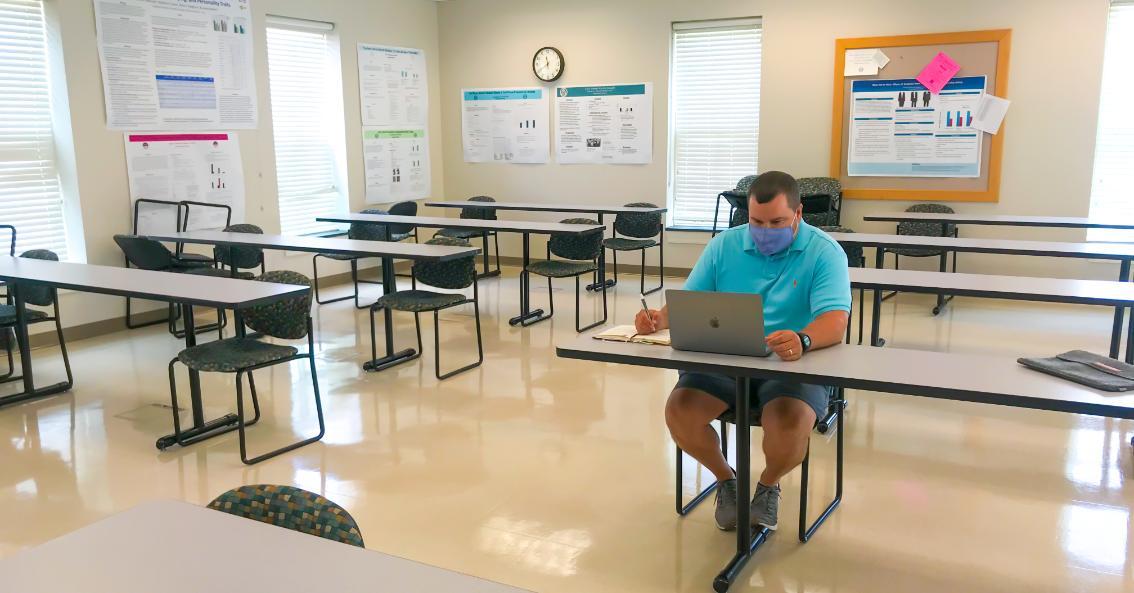
Every day this week, a team of people has been walking through academic buildings on campus, stopping at every classroom. One of them, Russ Carmichael, director of planning and real estate services, carries his laptop filled with data about each room.
Carmichael is leading the effort to arrange classrooms so that every student and faculty member in class is socially distanced while inside, working closely with leaders in Longwood’s Division of Academic Affairs. That classroom setup is a key part of Longwood's re-opening plan that was approved by the State Council for Higher Education and Virginia Department of Health on Friday, July 24. It’s a big job, but Carmichael has spent his career processing large amounts of data and planning for future needs. We sat down with Russ to talk about the work he’s been doing, and how Longwood classrooms will look and work this fall.
You started at Longwood in 2019 after nearly 15 years working for the State Council for Higher Education in Virginia. Did you ever expect that this is what you’d be doing?
I did not. In my years of service in higher education here in the Commonwealth, I thought I’d seen it all, including the great recession in 2008-09. I don’t think anyone expected this, but I’m happy that I’m just one of many people across campus who are helping get us ready for next semester with the safety of our students, faculty and staff in mind.
How are we setting up classrooms for social distancing requirements?
We are exceeding Centers for Disease Control guidelines on social distancing inside buildings, by keeping all students and faculty at least, if not more than, the requisite six feet apart while they are in class. That means rearranging chairs, tables, desks, lecterns, and other furniture in every classroom on campus.
We began the process by taking measurements of each room and coming up with an estimate of what we could fit into each space. We then fed the dimensions of each classroom and existing furniture into a space maximization computer program with parameters that take into account sizes of tables and chairs, lengths and widths of rooms, and spacing needs for students, among other variables, to make sure there’s space for the professor and people to walk in, and it returns a recommended arrangement. We use the computer output to best arrange furniture in a way that maximizes class seating availability while ensuring we aren’t compromising any spacing specifications that we adhere to. Then, this week we are going to each classroom making further adjustments based on the unique nature of the spaces. So each classroom is being assessed multiple times to ensure that social distancing is followed.
What has been the biggest challenge?
To be honest, it’s a lot easier at Longwood than I would have anticipated. Classes are already very small--especially Civitae classes--and with a new academic building opening up, we have more space than just last year. That’s not to say it’s not a complicated task--there are a lot of moving pieces--but we started ahead of the game compared with many of our peer institutions who have much more limited space.
Because of the spacing requirements, each classroom is losing between 50 and 60 percent of its capacity. That means that a classroom that has a capacity of 40 people could be down to under 20. It’s going to require some creativity when Academic Affairs staff assigns classes to their rooms, but we can do it.
What will be the biggest change to classroom setups this year?
Classrooms will look a lot differently than students and faculty are used to. In many classrooms there will be fewer tables present to allow for that extra social distancing, and there will only be one or two students at each table. For classrooms with desks, there will be much more space around them than students are used to. And of course, face coverings will be required in classroom settings. So there will be some differences in appearance, but we think the fundamental in-person learning experience will be preserved.
Will there be any other major changes?
Academic Affairs is adjusting the Monday-Wednesday-Friday schedule to give students more time to move between classes and ensure they are in the correct spots in classes.
How has your financial planning expertise helped with this?
I’ve had the opportunity, in past years, to tour every public 2- and 4-year public institution in Virginia which has given me a vast perspective of how different universities use different spaces. Previously in my career, I focused on operations and capital outlay, so planning has always been something I’ve been involved in. Financial planning, in particular, is looking at needs into the future and making sure you are in a position to fill those needs. That’s exactly what this is--we are looking at what classroom space is needed versus what we have, and making decisions accordingly.


Leave a Comment